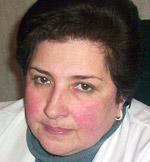Armenian students are not that healthy. According to the director of the Yerevan Students’ Polyclinic Anna Hovhannisyan, based on studies conducted throughout the past years, the majority of students are diagnosed with first degree diseases. For example, 2100 students of the Yerevan State University have gone through polyclinic examinations and studies show that there are more than 2200 illnesses, of which 762 are sight problems. Basically, there is a certain group of healthy students, yet there are others that do have some illnesses. According to Hovhannisyan, every second student has problems with the nervous system, while every third student has sight problems. Most of the students are short-sighted. The doctor of the polyclinic gives two reasons for the high number of short-sighted students. First of all, it has to do with the fact that during the post-independence years, due to the energy crisis, many were forced to read or write under a candle and the light of the candle had a great impact on the vision. The second reason is computers, which may cause severe effects on the eye. Many students complain about headaches after computer class and some teachers permit them to not sit in class due to future eye problems. There are also students with heart and intestine problems. During the past couple of years, there is a rise in students with tuberculosis. Studies show that tuberculosis is widespread among students that have just returned from the army, or students that have had any contact with someone diagnosed with tuberculosis. Many of the cases have been students that have been infected by the army soldier with tuberculosis. There haven’t been any infections among students. The contagious students are isolated, examined more carefully in special anti-tuberculosis dispensaries and the students that are not contagious are allowed to go to school. “We give permits to at least 10 students with tuberculosis a year,” says A. Hovhannisyan.
Currently, the students’ polyclinic serves nearly 54,000 students, of which 22,612 are students from the state university and are examined free of charge. The students from the regions that don’t study in the state university can only be examined at their local polyclinics. The entire, yearly budget for the polyclinic is 49 million AMD (108,000 dollars).
“This is not enough for the high number of students, especially now when there are more students coming to the polyclinic after hearing about the first aid free of charge,” says A. Hovhannisyan. The director says that they have no problems with the staff.
“The doctors and nurses at the polyclinic are licensed professionals.”
The polyclinic administration mainly complains about the lack of technological devices.
“Although we have all the necessary equipment we need, however they are kind of old. We don’t have the up-to-date technical equipment, which will give us an opportunity to come up with a correct diagnosis,” says the director of the polyclinic.
Just last year, the polyclinic got a special ear checking device from the Ministry of Health (this is the only polyclinic in Armenia that is under the control of the Ministry of Health). But universities could also have helped the polyclinic.
“We have asked help from many universities, but we finally realized that we just have to rely on ourselves,” says A. Hovhannisyan. The polyclinic has remodeled the building with the fees during the past five years-the polyclinic now has new windows, a new roof, bathrooms, offices, and even a separate water pipeline. Despite this, the polyclinic still doesn’t leave a very good impression and the patient would think twice before coming here. Based on a student survey, students tend to not come to the polyclinic even when they have serious problems. They usually come here to get a doctor’s note.

